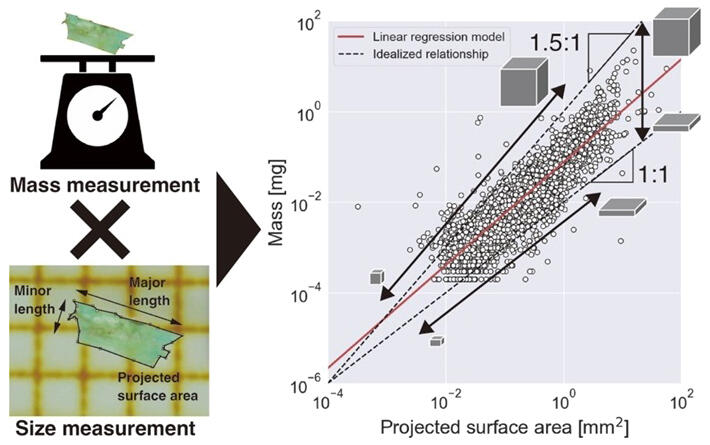A research group led by Associate Professor Tomoya Kataoka of Ehime University's Graduate School of Science and Engineering, Professor H. Hadiyanto of Diponegoro University (Indonesia), and Professor Yasuo Nihei of the Faculty of Science and Technology of Tokyo University of Science conducted research focusing on the geometric relationship between the masses of meso- and microplastic (MMP) particles smaller than 5 mm and their projected surface area. From this, the research group announced that they successfully improved the accuracy of mass estimates of MMP particles. This work is expected to assist with clarifying the effects of plastic particles on the plastic budget in the aquatic environment and the ecosystem. The results were published in the international journal Water Research on July 8.

The linear relationship between the mass and projected surface area of meso- and microplastic (MMP) particles was clarified by directly measuring those of 4,390 MMP particles, which was geometrically validated by assuming the shape and polymer density of the MMP particles. This relationship can be used to accurately estimate the mass concentration of MMP particles in aquatic environments.
Provided by Ehime University
Many aquatic environmental studies have been performed to collect plastic particulates and estimate their piece count-based concentrations and masses. However, the accuracy of mass estimates of individual plastic particles has been insufficiently verified.
In this study, the mass of 4390 MMP particles collected at 35 sites in 17 rivers in Japan was measured on an ultramicrobalance, obtaining the plastic mass concentration on a real-world basis. The projected surface area of all MMP particles was also measured. The results revealed a significant geometric relationship between particle mass and projected surface area.
The research group conceived a novel equation for converting the projected surface area of MMP particles to their mass. When this equation was used for estimating the mass of plastic particles, it was possible to readily and accurately evaluate the mass concentration of plastic in the environment. Estimating the mass of plastic particles using the above-mentioned conversion equation is expected to improve the accuracy of evaluating the effects of plastic particles on the plastic budget in the aquatic environment and the ecosystem.
Kataoka stated, "From the results of this research, we will be able to estimate the amount of plastic discharged from land to sea more accurately than before. Therefore, we expect that the results will help to verify the effectiveness of measures to control plastic discharge into the ocean and evaluations of the impact of plastic particles on the ecosystem."
Journal Information
Publication: Water Research
Title: Geometric relationship between the projected surface area and mass of a plastic particle
DOI: 10.1016/j.watres.2024.122061
This article has been translated by JST with permission from The Science News Ltd. (https://sci-news.co.jp/). Unauthorized reproduction of the article and photographs is prohibited.




